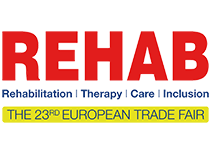Neurological research into paraplegia – Insights from Heidelberg University Hospital exclusively for REHAB conference delegates
»New developments in neurotechnology for paraplegia« - this lecture title in the CON.THERA congress programme parallel to REHAB 2023 sounds a bit like a medical miracle. Professor Rüdiger Rupp explains what it is all about.
“Here at Heidelberg University Hospital, we take research into paraplegia very seriously. Unfortunately, many of our major projects that relied on international funding were paused or even went backwards during the pandemic”, rues Professor Rüdiger Rupp from Heidelberg University Hospital.
“Nevertheless, the latest studies give us hope that stimulation implants in the spinal cord will be able to improve certain functions in future. Brain-computer interfaces can be used to intuitively control neuroprostheses or robot arms for paraplegic patients with severely injured spinal cords. But it can take a very long time for highly advanced technology like this to reach patients”, continues Rupp.
His research laboratory for assistive neurotechnology is located right next to the hospital’s paraplegic clinic. “This allows the results of our research to flow into patient treatment quickly. We can measure and observe how living aids and neuro-orthoses help patients. This is extremely important, as these tests are the only way for us to find out whether these devices only work in laboratory conditions and are too complex to be suitable in everyday life.”
Paraplegiology research area
Rupp is a qualified engineer from Karlsruhe who founded his own research area at Heidelberg’s renowned Spinal Cord Injury Center 27 years ago. In this time, the patients undergoing treatment have changed greatly, with the average age now over 60. This is because, instead of the typical motorcycle or bathroom accidents among young men, it is neurological and orthopaedic diagnoses like inflammatory and degenerative spinal cord conditions or tumours that are now the most frequent causes of paraplegia.

Patients who suffer paralyses like these that are not the result of accidents often have some degree of function remaining. As with able-bodied people, it is possible to improve and train these functions with repeated motions and targeted exercises. In the early phase in particular, patients require support when performing these movements. It is here that robotic training devices like the Lokomat or exoskeleton are used to relieve therapists. Treatment outcomes can be significantly improved with the support of innovative electrical stimulation systems, some of which can be implanted in a patient’s body.
"No risk, no fun"
Professor Rupp explains: “Each person and each spinal cord injury needs to be treated on an individual basis. Patients spend much less time here at the clinic than in the past, which gives us much less time to prepare them to live autonomously at home. This calls for a lot of self-motivation. The peer programmes at Germany’s Paraplegic Support Association (FGQ) are of great help here. This is a community of people who have lived with paraplegia for many years and have plenty of useful tips for returning to everyday life, family and work.”
For many years, Rupp has been active on the board of the German Paraplegia Association, which supports the work of the FGQ with its “No risk, no fun” prevention campaign.
The advances in assistive technology are already having a positive effect. Smart gloves that use external electrodes to activate paralysed muscles can help patients eat and drink independently again. Some people with severe paraplegia are able to consciously control the motions and grasping actions of a robot arm. To do so, however, they have to mentally break the desired movement down into partial steps and perform one step after the other.
Eye trackers fitted in special glasses can execute these actions much faster and more intuitively, so patients can move the arm or wheelchair in the desired direction. But this technology is not entirely unsusceptible to errors and is not suitable for every patient in everyday life.
Marketplace at REHAB 2023
Even if the miracle of being able to heal spinal cord damage remains a distant prospect, the broad range of customised aids, digital solutions and virtual reality applications gives reason for optimism in therapy and everyday life for patients. At REHAB 2023, users will find ideas and contacts at the Mobility & Daily Living Aids and Cerebral & Neurological Rehabilitation marketplaces, as well as at the joint stand of DATEurope, the European industry association for digital assistive technology.
Annika Gehrmeyer, who leads the REHAB project, is pleased with the focus on neurotechnology at REHAB 2023 and the CON.THERA conference: “We see at trade fairs all over the world how the latest developments, improvements and innovations are reaching the people who need and use them faster and faster. It is becoming increasingly important to discover new technologies, try them out and share experiences of premium living aids.”
Hand-arm use has top priority
Professor Rupp sums up: “I still find it incredibly moving to hear stories of young people who suffer bathing accidents, as these often result in severe paraplegia in the cervical spine with little hope of recovery in motor skills. Over the years, we have learned that rather than walking, the thing that people with paraplegia want most is to be able to use their hands and arms. This ranks alongside controlling bladder, bowel and sexual functions. All medical professionals must listen closely to their patients and work together to achieve true quality of life.”
Find more information about the topic:

